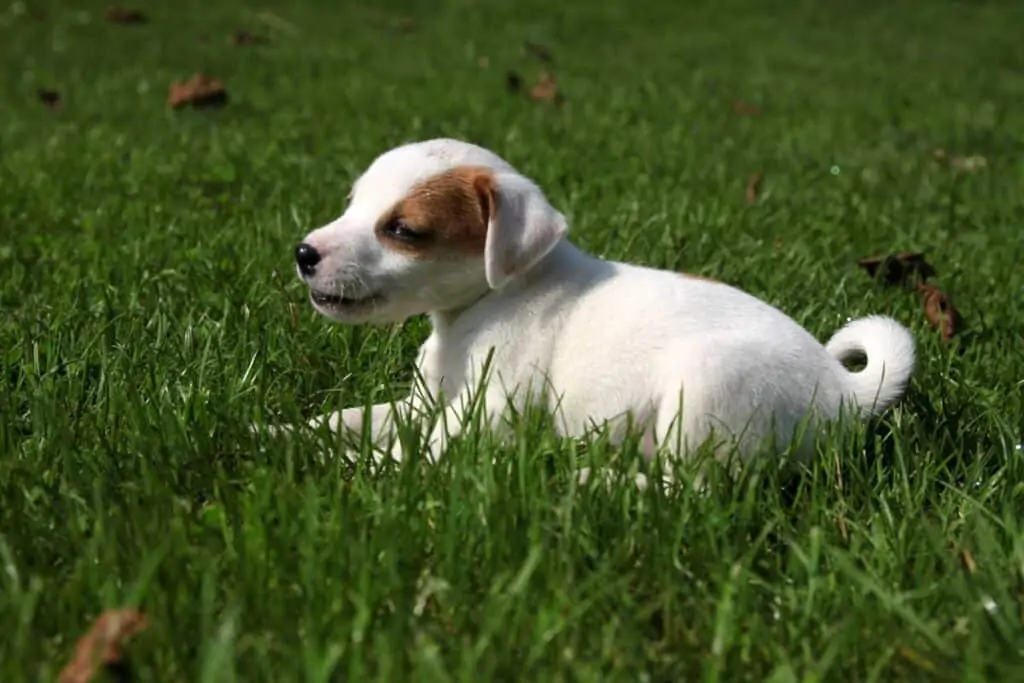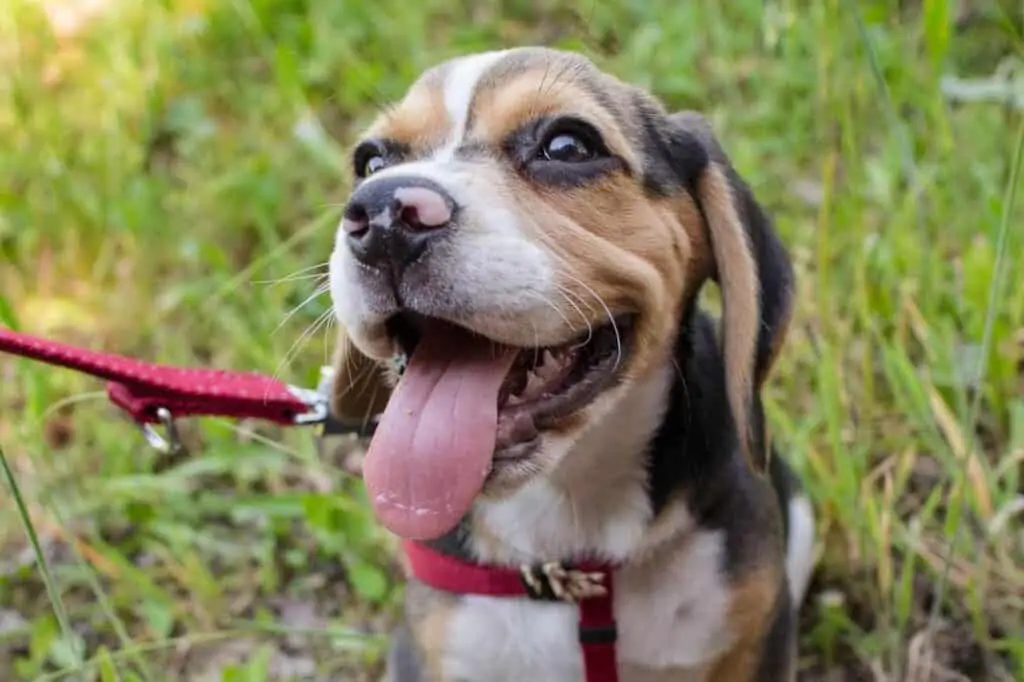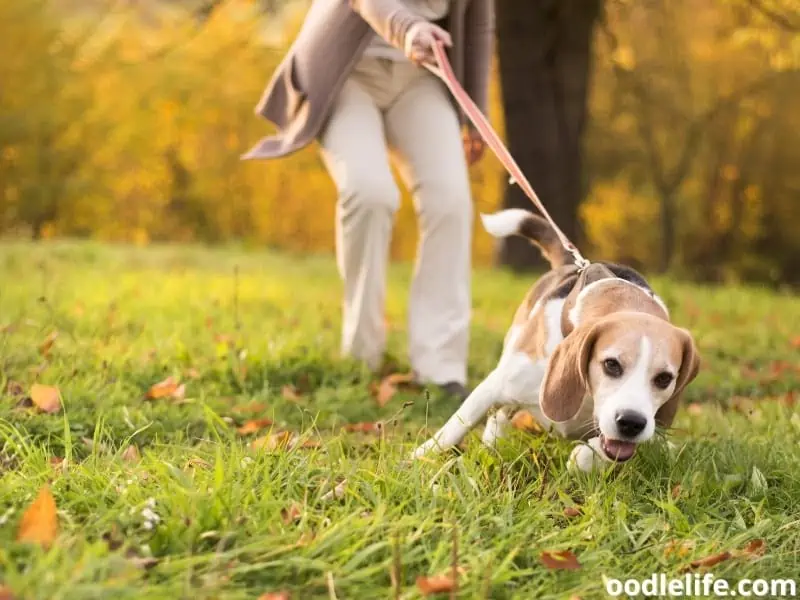Beagle Behavior By Age [Guide]
There are many reasons why Beagles are one of the most popular dog breeds. For starters, they are adorable, with their big ears and endearing faces. But there is more to them than just their looks.
Beagles are also intelligent, playful dogs that make great companions.

They are relatively easy to train and are known for being gentle and good-natured. These happy-go-lucky dogs are often found to be happy, loyal, and affectionate. Some Beagle owners even find that they can reduce stress through their pooches, which is why Beagles are frequently employed as therapy or emotional support dogs.
Dogs, just like humans, vary their behavior significantly depending on their age and their stage of life. It is not uncommon to have a Beagle puppy that is an absolute terror during puppyhood grow into a well-mannered, balanced adult canine.
In this blog post, we’ll take a quick look at the history of the Beagle to better understand their instincts, and chart a Beagle’s growth throughout the years to give you an idea of what to expect.
The Beagle – A Brief History
The Beagle is a popular breed of dog that has a long history. Native to Great Britain, the Beagle was originally used for hunting hare. They are scent hounds with a superior sense of smell and tracking instincts compared to other breeds of dogs.

They are independent dogs that are used to working in partnership with humans, often running off on their own in chase of a hare or fox. In addition, their superb sense of smell allows them to follow their noses without needing much guidance from humans.
All of these factors combine to make Beagles one of the most popular choices for hunting dogs in the 1800s.
The breed soon became popular as a companion animal due to its friendly temperament and eagerness to please. Today, the Beagle is still prized as a pet, and it is also used for various activities such as search and rescue, tracking, and drug detection.
Of course, not all Beagles were born working dogs! As puppies, they are some of the most adorable, yet mischievous pups that will often get into all sorts of trouble. Now let’s look at what you can expect from a Beagle throughout the various stages of its life.
Two To Four-Month Puppy
During puppyhood, Beagles are curious and playful. Not only are they learning everything for the first time, but at this age, their energy levels are high and they can be relatively hyperactive. This is when Beagles, like almost all other dogs, are curious, and will want to do nothing but play, sleep, and eat.

They will sleep 18 to 20 hours a day when they aren’t running around driving you batty. There’s no need for a rigid exercise routine at this stage, as Beagles tend to be active dogs that will play until they drop with tiredness.
There will be much learning to be done during this period, which is known as the late sensitive period. Training sessions with short lessons on basic commands and acceptable behavior are not too early to begin. By setting boundaries and rules now, you will be able to avoid any behavioral problems in the future.
Of course, you’ll want to already potty train your Beagle. They are clean animals, and crate training would be ideal for a Beagle pup.
Crate training is often recommended as a way to help puppies learn how to control their bladder and bowel movements. The idea is that puppies will not want to soil the area where they sleep, so they will learn to hold it until they are taken outside.
Additionally, crate training can help to establish a regular potty-time routine. By taking the puppy out at the same time each day, he or she will learn when it is time to go and will be less likely to have accidents in the house.
In addition, crating a young pup will keep them out of trouble and save you some expensive repair bills as your puppy attacks everything with its teeth. They are teething and exploring with their mouths, and it is natural for puppies to want to gnaw on everything.
Keep plenty of chew toys and dental sticks on hand to redirect their attention to their own toys. Beagles are notorious chewers and are likely to cost you plenty in damage to your shoes, furniture, and whatever they can get their jaws on.
This is also when socializing your Beagle is critical. Once your Beagle is fully vaccinated, take him or her to meet as many people, dogs, and other animals as possible. Beagles are hunting dogs and are going to have extremely high prey drives, which means they will chase down anything that moves.
Early and extensive socialization is required once it is safe for a pup to be out.
Four To Six Month Pup
When your puppy reaches this age, you’ll be able to see how energetic he is. You might even be chewed on and bitten in play as they slowly start to learn where your boundaries are. Some Beagles wanting to play or attention might even bark incessantly to get your attention and response.

Nip these problems in the bud immediately and don’t let them push their limits. Dogs can also be impulsive creatures, acting on their desires without thinking about the consequences. This can lead to problems like jumping on guests or chewing up your favorite pair of shoes.
Now’s a good time to get your dog familiar with discipline and impulse control. To teach impulse control, you can teach the command “leave it,” and “drop it.” To do that, put a treat in your hand and show it to your dog.
As soon as he starts to sniff or go for the treat, say “leave it” in a firm voice.
When he backs away from the treat, give him praise and then give him the treat as a reward. Also, make your dog sit for everything, whether it is for treats or for you to put a leash or collar on.
You may also see them attempt to become alpha themselves later in this stage. Ensure that they are taught the pack hierarchy. Despite being a member of your family, they need to be aware that they are on the bottom of the totem pole.
6 To 12-Month Old Pup
With each passing day, your Beagle will become calmer. There will be a gradual decrease in the number of bad behaviors they exhibit. The pup will become more obedient if you train it consistently and reinforce it with positive reinforcement.
It is normal for your Beagle to test their boundaries from time to time. Their destructive behavior can include chewing on furniture or destroying other belongings. As a result, regular training and positive reinforcement are essential.
However, they will remain hyperactive and equally curious about everything. Their curiosity will keep them exploring new places and smelling new smells as they grow older. A male Beagle may develop the habit of humping things, including humans.

12 to 24 Month Adult
Adulthood begins here. As far as physical appearance is concerned, your Beagle resembles an adult and has matured in some ways. Even so, they still possess the energy of puppies and are generally fairly hyperactive.
Exercise is crucial to their health. The prevention of boredom also requires mental stimulation and enrichment. Beagles should be well behaved and non-behavioral issues should not have arisen in the first year if they have been trained, socialized, and given proper physical and mental exercise.
However, there is still a lot to be done. The rules and boundaries should be adhered to as well as exercising and enriching them as much as possible. By doing this, we can prevent the development of any new behavior problems.

2 and 8 Years
When your Beagle turns two, he or she will be ready to become a young adult. It is still important to keep exercising and enriching them while at their physical peak.
Despite being less hyper than at 1 or 2 years of age, they are still highly energetic. By now they would have become more familiar with playtime and chill-out time and would have become more settled and controlled.

Over 8 Years
A Beagle is considered a senior dog after about eight years of age. In general, a Beagle’s lifespan is somewhere between 12 and 15 years. You won’t notice a sudden decline in their energy levels just because they have turned 8 years old.
The amount of exercise you give them should be adapted to their needs, but you should not forget the importance of exercise.
There is a possibility of them developing normal old-age health issues such as arthritis as they age. It is important to balance exercise with other activities. The muscles will become sore if you exercise too much, while insufficient exercise will result in a loss of mobility and weight gain.

Final Thoughts
Dogs are social creatures by nature, and they thrive when they have regular contact with other dogs. Socialization helps to ensure that your dog is well-adjusted and capable of interacting calmly and confidently with other dogs. It can also help to prevent behavioral problems from developing, such as aggression or fearfulness.
For all of these reasons, it is essential to make sure that your dog has plenty of opportunities to socialize with other dogs regularly.